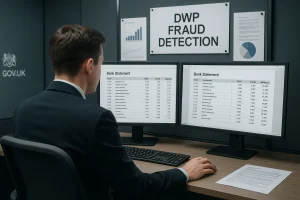The Department for Work and Pensions (DWP) is intensifying efforts to combat benefit fraud by introducing bank account checks, including for individuals not currently claiming benefits.
As part of a wider £9 billion fraud prevention plan, the initiative aims to safeguard public funds and improve claim accuracy.
Through legislative reform, data-sharing partnerships, and advanced analytics, the government seeks to ensure that benefits reach only those genuinely entitled, while deterring those seeking to exploit the welfare system.
Why Is the Department for Work and Pensions Introducing Bank Account Checks?

The Department for Work and Pensions (DWP) is implementing bank account checks as part of a wider strategy to tackle rising benefit fraud.
This decision follows increasing concerns about the misuse of taxpayer funds, especially within the Universal Credit system.
Over the past year, the government has managed to save more than £1.3 billion through existing anti-fraud measures, and the latest plan aims to build on this success.
Recent investigations uncovered a £53.9 million fraud case, marking the largest ever Universal Credit scam in the UK.
Cases like this have highlighted vulnerabilities in the current system. To address them, the DWP has introduced measures that expand its reach, even to those not actively claiming benefits, if there’s reason to suspect fraudulent activity.
The goal is not just to detect fraud retrospectively but to prevent it from occurring in the first place.
By using early detection tools such as account verification, the DWP seeks to proactively identify inconsistencies in financial behaviour that may indicate benefit misuse.
How Will the DWP Access and Use Bank Account Data?
The data access proposed by the DWP will operate under the legislative framework of the Data Protection and Digital Information Bill, which is currently progressing through Parliament.
The new powers would allow third-party institutions, such as banks, to share relevant and specific information with the department. This does not mean the DWP will have unrestricted access to personal bank accounts.
Instead, banks will provide data points that can suggest potential fraud. These include indicators such as unusually high balances for someone claiming means-tested benefits or multiple large deposits inconsistent with declared income.
Importantly, the information will be limited and contextual. The DWP will not be privy to itemised statements or spending details.
Decisions based on this data will be made by trained DWP agents rather than automated systems alone.
This combination of technology and human oversight is intended to protect against both false positives and data misuse.
Key data signals the DWP may review include:
- Evidence of undeclared savings
- Patterns suggesting employment not reported in claims
- Multiple accounts associated with one individual
- Financial activity inconsistent with declared circumstances
Who Will Be Affected by These New DWP Fraud Measures?

The DWP’s fraud crackdown will not be limited to current claimants. The department is widening its net to include individuals who may be involved in previous or attempted fraudulent activity, even if they are not actively receiving benefits. Understanding who will be affected helps clarify the scope and impact of the policy.
Current Claimants of Means-Tested Benefits
The primary group impacted will be individuals claiming means-tested benefits, such as Universal Credit, where eligibility is determined by income and savings. These benefits are particularly vulnerable to fraud due to fluctuating personal and financial circumstances.
Claimants will face:
- Increased scrutiny during application and review stages
- More frequent verification requests
- Automated checks against real-time financial data
Those who fail to report changes in living arrangements, employment, or capital accurately could be flagged for investigation or penalised under new civil enforcement rules.
Individuals Not Currently Claiming Benefits
One of the more significant shifts in the DWP’s approach is the inclusion of people who are not actively claiming benefits. Under the new proposals, if bank data or other indicators suggest a person may have fraudulently claimed in the past, they may be reviewed.
For example, an individual who stopped claiming but had undeclared savings during their claim period may still be investigated retroactively. Additionally, those who begin a claim in the future may be subject to pre-eligibility checks based on prior financial history or digital red flags.
Groups Likely to Be Exempt or Less Affected
Some benefit recipients will face fewer checks due to the nature of their payments or low risk of fraud. This includes:
- Pensioners receiving State Pension only
- Individuals on non-means-tested benefits such as Personal Independence Payment (PIP)
- Claimants already subject to low-risk fraud ratings or those under regular review
The DWP has confirmed that these groups are not the primary targets of the fraud plan, although routine data matching may still apply in specific cases.
What Are the Key Elements of the Government’s £9 Billion Fraud Plan?
The DWP’s plan to recover £9 billion by 2027/28 is based on a combination of modern technologies, increased workforce capacity, and updated legal powers. These components are designed to work together to detect, prevent, and penalise benefit fraud across the system.
Expansion of the DWP Workforce
A key pillar of the plan involves recruiting over 2,500 additional agents to support fraud investigations. These new staff members will focus on reviewing millions of Universal Credit claims under the Targeted Case Review (TCR) programme.
This will involve:
- Scrutinising high-risk or flagged claims
- Cross-verifying data between departments
- Conducting follow-up investigations and interviews where required
In total, nearly 6,000 agents, including existing DWP staff, will work on fraud detection efforts under this plan.
New Civil Penalties and Legal Powers
To strengthen enforcement, the government is introducing new civil penalties that allow the DWP to sanction claimants without necessarily prosecuting them through the courts. This is particularly useful for cases where fraud is evident but not substantial enough to warrant full criminal proceedings.
Additionally, proposed legislation will give DWP investigators powers similar to those of HMRC, including the ability to:
- Execute searches with warrants
- Seize physical and digital evidence
- Arrest individuals during serious investigations
These powers aim to deter organised benefit fraud rings and make enforcement more efficient.
Data-Driven Technology and Automation
Technology forms the backbone of the DWP’s modern fraud plan. The department is deploying advanced tools to automate checks and enhance accuracy in fraud detection.
Technological enhancements include:
- Machine learning models that flag suspicious behaviour or inconsistencies
- Real-time verification of self-employed income, linked directly to banking data
- Automated capital checks to detect undeclared savings or assets
- Digital prompts to encourage claimants to regularly update circumstances
These tools help the DWP process claims faster while identifying fraudulent patterns that may otherwise go unnoticed.
Strategic Partnerships and Data Sharing
Effective fraud prevention requires collaboration. The DWP is working with banks, HMRC, and other government bodies to share information that supports fraud investigations. Under the Data Protection and Digital Information Bill, third parties will be required to provide limited financial data to the DWP, helping detect eligibility mismatches.
The data-sharing model is built around:
- Providing only essential information from banks
- Triggering investigations based on specific risk criteria
- Ensuring all shared data complies with UK GDPR
This strategic approach ensures that investigations are evidence-based while maintaining the privacy and rights of honest claimants.
Projected Outcomes and Timelines
The DWP anticipates significant financial returns from this plan. The government expects to save £9 billion by the end of the 2027/28 fiscal year through these coordinated efforts.
Below is a table outlining the estimated impact of the major elements of the plan:
| Initiative | Estimated Savings by 2027/28 | Implementation Timeline |
|---|---|---|
| Hiring of additional staff | £2 billion | 2023–2025 |
| Use of data analytics and AI | £1.5 billion | Ongoing |
| Automated capital and income checks | £1 billion | 2024–2026 |
| Bank account data sharing with third parties | £600 million | Subject to legislation |
| Legal and civil enforcement reforms | £500 million | Pending |
| Other operational and administrative savings | £3.4 billion | Phased |
These projections reflect the DWP’s commitment to not only recoup funds lost to fraud but also ensure long-term integrity and trust in the welfare system.
Are There Privacy or Civil Rights Concerns About These Checks?

With any policy involving data collection, there are natural concerns regarding civil liberties and personal privacy.
Critics of the DWP’s proposals have voiced fears about government overreach and the potential for errors leading to unjust sanctions.
However, the DWP has been careful to emphasise that the new powers will be used proportionally and within the legal boundaries of data protection law.
The checks do not grant DWP blanket access to financial records. Instead, financial institutions will be responsible for reviewing customer accounts and flagging cases that meet predefined risk criteria.
Only relevant and necessary information will be shared, and full bank statements or transaction details will not be disclosed.
To address privacy risks, the government is:
- Limiting the scope of data shared to essential fraud indicators
- Requiring human review before action is taken on any flagged case
- Ensuring compliance with UK General Data Protection Regulation (UK GDPR)
- Introducing oversight mechanisms to prevent misuse of data
The checks are not designed to penalise innocent claimants but to detect those attempting to exploit the system.
The DWP’s assurance of human oversight is intended to act as a safeguard against false accusations.
What Other Tools Is the DWP Using to Fight Benefit Fraud?
In addition to financial data checks, the DWP is deploying several technological and administrative innovations to detect and prevent fraud.
One of the central updates is the use of automation in areas where fraud risk is highest, particularly within Universal Credit.
Other tools being used include:
- Real-time income tracking for self-employed claimants to ensure income reporting aligns with actual bank deposits
- Online forms and declaration prompts reminding claimants to update their circumstances
- Integration with HMRC and other government databases to validate employment and income claims
- Machine learning algorithms that can detect anomalies such as duplicate applications, identity fraud, and patterns linked to organised scams
A key area of improvement is the introduction of partially automated checks on capital. These checks help verify whether claimants are below the savings threshold for means-tested benefits, reducing the risk of overpayments.
The table below presents the key technological tools and their intended functions:
| Tool/Feature | Purpose | Application Area |
|---|---|---|
| Automated Income Checks | Match earnings with declared amounts | Self-employed claims |
| Data-Matching with Other Departments | Validate claimant information | Cross-government |
| Online Declaration Prompts | Prompt users to update life or financial changes | Universal Credit |
| AI Pattern Detection | Identify unusual or high-risk behaviour in claims | All benefits |
| Capital Check Automation | Validate savings threshold compliance | Means-tested benefits |
These systems do not operate in isolation. They feed into a larger anti-fraud ecosystem where human analysts, legal experts, and policy teams collaborate to enforce the law fairly and effectively.
How Do These Measures Fit into Broader Welfare Reforms?

The DWP’s new fraud prevention strategy is part of a wider reform agenda announced by the UK government.
These reforms aim to modernise the welfare system by improving its efficiency, fairness, and resilience against abuse.
The Prime Minister has already outlined the next phase of welfare legislation, which will provide the DWP with greater powers, similar to those held by HMRC.
Key proposals within the broader reform package include:
- Granting DWP investigators the power to arrest and search premises under warrant
- Enabling seizure of evidence during fraud investigations
- Empowering the DWP to recover funds from fraudulent claims without relying solely on court judgments
- Revising benefit rules to make reporting obligations clearer and stricter
These changes reflect a shift in how benefit fraud is treated from a passive, reactive model to a proactive, investigatory model with legal enforcement.
The government’s long-term goal is to make the UK’s welfare system both compassionate and unexploitable, maintaining public trust and fiscal responsibility.
The alignment of DWP operations with HMRC processes also brings consistency in how financial wrongdoing is investigated across different arms of government.
It ensures that benefit fraud is treated with the same seriousness as tax fraud, reflecting its real cost to the public.
Conclusion
The DWP’s expanded powers and strategies mark a significant shift in how benefit fraud is tackled across the UK.
By combining legislative changes, advanced data tools, and targeted investigations, the department aims to enhance transparency and restore public confidence in the welfare system.
While privacy safeguards remain in place, the initiative sends a clear message: fraud will not be tolerated, and taxpayers’ money must be protected.
These reforms are designed to ensure fairness and long-term integrity in benefit distribution.
FAQs
What is the DWP’s new power regarding bank account checks?
The DWP will use limited data provided by banks under the Data Protection and Digital Information Bill to identify potential fraud. This does not involve full access to personal bank accounts.
Will the DWP be able to see my full bank account history?
No. Banks will only provide specific indicators that may suggest fraud or ineligibility. The DWP cannot view your transactions or monitor your spending habits.
What should I do if I’m contacted by DWP about a check?
You should respond promptly and honestly. Provide any requested documents or clarifications to avoid delays or penalties.
Are these checks targeting people who aren’t claiming benefits?
While the focus is on current claimants, checks may also apply to those suspected of previous fraud or those whose accounts may be flagged as part of broader data-matching exercises.
How does this plan relate to Universal Credit?
Universal Credit is a central focus of the fraud plan. The DWP is introducing automated income checks, declaration prompts, and targeted case reviews specifically for this benefit.
What is the role of data analytics in detecting benefit fraud?
Advanced analytics help identify patterns that suggest fraudulent activity. These tools assist DWP staff in making informed decisions but do not replace human judgment.
Can I opt out of DWP checks if I feel my privacy is being breached?
No, if you are claiming benefits, compliance with eligibility checks is a legal requirement. However, all checks are conducted under strict data protection laws.

Leave a Reply